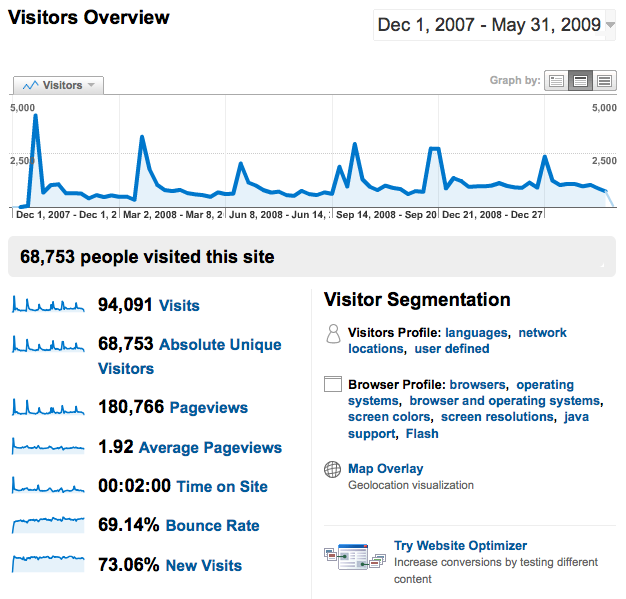by Tom Keays
The Code4Lib Journal website has been using Google Analytics since it first went live and we’ve found it fascinating to see how the site is used. Here are a few highlights. During the 18 month period from December 2007 through May 2009, the Journal has had almost 69,000 visitors for a total of 94,000 visits and almost 181,000 page views. Although 69% of our readership views only one page (this is what Google terms the “bounce rate”), a sizable proportion of you view 2-5 pages per session.

Google Analytics: Visitor Overview, December 1, 2007 – May 31, 2009
The Journal’s average number of visitors per day is about 172 since Issue 1 in December 2007. However, if you compare the most recent 12 months from June 2008 through May 2009 with the previous 6 months, readership increased 138% from 76 visits/day to 182 visits/day. Not surprisingly, the days surrounding publication of each issue sees a huge spike up to peaks of over 1,100 views per day.

Google Analytics: Visits for all Visitors Compared, December 1, 2007 – May 31, 2009
Of the Journal’s 75 HTML-formatted pages (as of Issue 6), including the homepage, 61 articles, 6 table of contents, and 6 utility pages, 7 of the top 8 pages viewed have been articles. These articles included:
- “Free and Open Source Options for Creating Database-Driven Subject Guides” by Edward M. Corrado and Kathryn A. Frederick, Issue 2.
- “Using Google Calendar to Manage Library Website Hours” by Andrew Darby, Issue 2.
- “LibraryH3lp: A New Flexible Chat Reference System” by Pam Sessoms and Eric Sessoms, Issue 4.
- “Beyond OPAC 2.0: Library Catalog as Versatile Discovery Platform” by Tito Sierra, Joseph Ryan, and Markus Wust, Issue 1.
- “The Rutgers Workflow Management System: Migrating a Digital Object Management Utility to Open Source” by Grace Agnew and Yang Yu, Issue 1.
- “COLUMN: We Love Open Source Software. No, You Can’t Have Our Code” by Dale Askey, Issue 5.
- “Facet-Based Search and Navigation With LCSH: Problems and Opportunities” by Kelley McGrath, Issue 1.

Google Analytics: Top Content, December 1, 2007 – May 31, 2009
Articles from the first 2 issues are still being read over a year later and more current articles are also claiming significant readership. The editors are understandably pleased with this trend and see it as a measure of the high quality of the articles. But it is the Code4Lib community itself that has all the bragging rights. Our successes, indeed, are yours.
The Journal’s mission from the very beginning has been “to foster community and share information among those interested in the intersection of libraries, technology, and the future.” The Code4Lib community continually shows the depth and diversity of knowledge of the librarians and coders of which it is made, not just here in the pages of this journal, but in the email discussions on the Listserv, in conversations on the IRC channel, at the annual conference and a growing number of regional meetings, and wherever and however we connect, interact, and share our expertise and knowledge. It is a pleasure to be a part of it all.
Long may you run!
Code4Lib Journal Editorial Changes
This issue sees the departure of one editor and arrival of another. We gratefully acknowledge the contributions of Christine Schwartz, who served as an editor for Issues 3 – 7 and was the coordinating editor for Issue 6. Christine, who also blogs at Cataloging Futures about RDA, MARC21, ILS and OPACs, and a variety of topics centered on cataloging and metadata, is the Metadata Librarian at Princeton Theological Seminary Libraries. Since many of the Journal’s articles have touched in these areas, her knowledge and experience has been invaluable.
We are pleased to welcome Kelley McGrath, who is Cataloging & Metadata Services Librarian (Audiovisual) at Ball State University and also serves as the chair of Online Audiovisual Catalogers (OLAC) Cataloging Policy Committee. Kelley has authored two articles in Code4Lib Journal, including “Facet-Based Search and Navigation With LCSH: Problems and Opportunities” in Issue 1 and “Identifying FRBR Work-Level Data in MARC Bibliographic Records for Manifestations of Moving Images” in Issue 5.
As always, if you would like to become involved with the production of The Code4LIb Journal, email the editorial committee at c4lj-discuss@googlegroups.com and let us know how you are able to contribute.


Subscribe to comments: For this article | For all articles
Leave a Reply